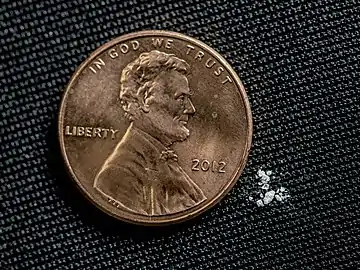Carfentanil
Carfentanil or carfentanyl is a structural analog of the synthetic opioid analgesic fentanyl.[1] Carfentanil was first synthesized in 1974 by a team of chemists at Janssen Pharmaceutica which included Paul Janssen.[2] The effects of carfentanil, including overdose, can be reversed by naloxone.[3]:23 Carfentanil is legally controlled in most jurisdictions, but has veterinary uses for anaesthetising large animals, such as elephants and bears.
 | |
| Clinical data | |
|---|---|
| Trade names | Wildnil |
| Other names | Methoxycarbonyl-fentanyl |
| AHFS/Drugs.com | International Drug Names |
| ATC code |
|
| Legal status | |
| Legal status |
|
| Pharmacokinetic data | |
| Elimination half-life | 7.7 hrs |
| Identifiers | |
| |
| CAS Number | |
| PubChem CID | |
| DrugBank | |
| ChemSpider | |
| UNII | |
| ChEBI | |
| ChEMBL | |
| CompTox Dashboard (EPA) | |
| Chemical and physical data | |
| Formula | C24H30N2O3 |
| Molar mass | 394.515 g·mol−1 |
| 3D model (JSmol) | |
| |
| |
| (verify) | |
Typical use
Carfentanil was sold starting in 1986 under the brand name "Wildnil" for use in tranquilizer darts in combination with an α2-adrenoreceptor agonist[3]:9 for large mammals including elk and elephants.[2][4] It was chosen for its high therapeutic index. Commercial production of Wildnil ceased in 2003, and the drug is available only as a compounded dosage form.[5]
Modern history
Increase in illicit use
A November 2016 article in Time, "Heroin Is Being Laced With a Terrifying New Substance: What to Know About Carfentanil", reports over 300 cases of overdose related to fentanyl and fentanyl analogues and several deaths connected to the drug since August 2016 in several of the United States, including Ohio, West Virginia, Indiana, Kentucky and Florida.[9] In 2017, a Milwaukee, Wisconsin man died from a carfentanil overdose, likely taken unknowingly with another illegal drug such as heroin or cocaine.[10] Carfentanil is most often taken with heroin or by users who believe they are taking heroin. Carfentanil is added to or sold as heroin because it is less expensive, easier to obtain and easier to make than heroin.[11] Health professionals are increasingly concerned about the potential escalation of public health consequences of its recreational use.[12]
Importation from China
According to an Associated Press article from 2016, "Chemical weapon for sale: China's unregulated narcotic", fentanyl, carfentanil and other highly potent derivatives of fentanyl were actively marketed by several Chinese chemical companies.[11] Carfentanil was not a controlled substance in China until 1 March 2017,[13] and until then was manufactured legally and sold openly over the Internet.
Authorities in Latvia and Lithuania reported seizing carfentanil as an illicit drug in the early 2000s.[11][14] Around 2016, the US and Canada started reporting a dramatic increase in shipment of carfentanil and other strong opioid drugs to customers in North America from Chinese chemical supply firms. In June 2016 the Royal Canadian Mounted Police seized one kilogram of carfentanil shipped from China in a box labeled "printer accessories". According to the Canada Border Services Agency, the shipment contained 50 million lethal doses of the drug, more than enough to wipe out the entire population of the country, in containers labeled as toner cartridges for Hewlett-Packard LaserJet printers. Allan Lai, an officer-in-charge at the Royal Canadian Mounted Police in Calgary who helped oversee the criminal investigation said, "With respect to carfentanil, we don't know why a substance of that potency is coming into our country."[11]
Moscow theater hostage crisis
In 2012, a team of researchers at the British chemical and biological defence laboratories at Porton Down found carfentanil and remifentanil in clothing from two British survivors of the 2002 Moscow theater hostage crisis and in the urine from a third survivor. The team concluded that the Russian military used an aerosol mist of carfentanil and remifentanil to subdue Chechen hostage takers.[15]
Authors of a previous paper in the Annals of Emergency Medicine surmised from the available evidence that the Moscow emergency services had not been informed of the use of the agent, but were instructed to bring opioid antagonists. Not knowing to expect hundreds of patients exposed to high doses of strong opioids, the emergency workers did not bring enough naloxone or naltrexone (the two most commonly used opioid antagonists) to counteract the carfentanil and remifentanil and save the lives of many of the victims. 125 people exposed to the aerosol used in the rescue attempt are confirmed to have died from both respiratory failure and aerosol inhalation during the incident. The authors state that, assuming carfentanil and remifentanil were the only active ingredients of the knockout gas, the worst danger to the theater victims would have been apnea (loss of breathing), and that mechanical ventilation and/or treatment with opioid antagonists could have saved many lives.[16]
Potential as a chemical weapon
The toxicity of carfentanil in humans and its ready commercial availability has aroused concerns over its potential use as a weapon of mass destruction by rogue nations and terrorist groups.[11]
The toxicity of carfentanil has been compared to that of nerve gas, according to the Associated Press' article "Chemical weapon for sale: China's unregulated narcotic". The article quoted Andrew C. Weber, Assistant US Secretary of Defense for Nuclear, Chemical and Biological Defense Programs from 2009 to 2014, as saying "It's a weapon. Companies shouldn't be just sending it to anybody." Weber added "Countries that we are concerned about were interested in using it for offensive purposes... We are also concerned that groups like ISIS could order it commercially." Weber described various ways carfentanil could be used as a weapon, such as knocking troops out and taking them hostage or killing civilians in enclosed spaces such as railway stations.[11]
Pharmacology
Carfentanil is a lipophilic chemical, and can easily cross the blood-brain barrier. It has very rapid onset of effects, but is also shorter acting than fentanyl.[3]:9
For pain relief, a unit of carfentanil is 100 times as potent as the same amount of fentanyl, 5,000 times as potent as a unit of heroin and 10,000 times as potent as a unit of morphine. This is despite only having 14-135 times higher affinity for the μ receptor.[17][3]:9 Despite its higher potency, carfentanil is less fatal than fentanyl in rats.[18][19]
Legal status
China
Carfentanil has been controlled in China since 1 March 2017.[3]:21 The trade war between China and the US has included controversy over the effectiveness of this control.[20][21][22]
United States
Carfentanil is classified as Schedule II under the Controlled Substances Act in the United States with a DEA ACSCN of 9743 and a 2016 annual aggregate manufacturing quota of 19 grams (less than 0.7 oz.).[23]
United Kingdom
Carfentanil has been specifically controlled as a Class A drug since 1986[24]
See also
- 4-Phenylfentanyl
- Lofentanil (3-methylcarfentanyl)
- N-Methylcarfentanil
- Sufentanil
- Thiafentanil
- Opioid comparison
- R-30490 (4-methoxymethylfentanyl)
References
- "Fentanyl drug profile". EMCDDA.
- Stanley TH, Egan TD, Van Aken H (February 2008). "A tribute to Dr. Paul A. J. Janssen: entrepreneur extraordinaire, innovative scientist, and significant contributor to anesthesiology". Anesthesia and Analgesia. 106 (2): 451–62, table of contents. doi:10.1213/ane.0b013e3181605add. PMID 18227300. S2CID 20490363.
- "Report on the risk assessment of methyl 1-(2-phenylethyl)-4-[phenyl(propanoyl) amino]piperidine-4-carboxylate in the framework of the Council Decision on new psychoactive substances" (PDF). European Monitoring Centre for Drugs and Drug Addiction. 8 July 2018.
- Jacobson ER, Kollias GV, Heard DJ, Caligiuri R (1988). "Immobilization of African Elephants with Carfentanil and Antagonism with Nalmefene and Diprenorphine". The Journal of Zoo Animal Medicine. 19 (1/2): 1–7. doi:10.2307/20094842. JSTOR 20094842.
- World Health Organisation, Carfentanil Critical Review Report (PDF), retrieved 3 September 2018
- "Fentanyl. Image 4 of 17". Drug Enforcement Administration.
- "DEA Issues Carfentanil Warning To Police And Public". United States Drug Enforcement Administration. 22 September 2016.
The lethal dose range for carfentanil in humans is unknown
- Concheiro M, Chesser R, Pardi J, Cooper G (2018). "Postmortem Toxicology of New Synthetic Opioids". Frontiers in Pharmacology. 9: 1210. doi:10.3389/fphar.2018.01210. PMC 6212520. PMID 30416445. 26 October 2018. From the conclusion: "Postmortem concentrations seemed to correlate with their potency, although the presence of other CNS depressants, such as ethanol and benzodiazepines has to be taken into account."
- Sanburn J. "Heroin Is Being Laced With a Terrifying New Substance". TIME.com. Retrieved 24 November 2016.
- Stephenson C (17 April 2017). "Carfentanil, 10,000 times more potent than morphine, kills homeless man in Milwaukee". Milwaukee Journal Sentinel. Retrieved 17 April 2017.
- Kinetz E, Butler D (7 October 2016). "Chemical weapon for sale: China's unregulated narcotic". AP News. New York, NY 10281 USA. The Associated Press. Archived from the original on 30 July 2018. Retrieved 12 April 2016.CS1 maint: location (link)
- Baumann MH, Pasternak GW (January 2018). "Novel Synthetic Opioids and Overdose Deaths: Tip of the Iceberg?". Neuropsychopharmacology. 43 (1): 216–217. doi:10.1038/npp.2017.211. PMC 5719114. PMID 29192657.
- "China makes deadly opioid carfentanil a controlled substance". Associated Press via theday.com. 15 February 2017. Retrieved 29 July 2019.
- Mounteney J, Giraudon I, Denissov G, Griffiths P (July 2015). "Fentanyls: Are we missing the signs? Highly potent and on the rise in Europe". The International Journal on Drug Policy. 26 (7): 626–31. doi:10.1016/j.drugpo.2015.04.003. PMID 25976511.
- Riches JR, Read RW, Black RM, Cooper NJ, Timperley CM (November 2012). "Analysis of clothing and urine from Moscow theatre siege casualties reveals carfentanil and remifentanil use". Journal of Analytical Toxicology. 36 (9): 647–56. doi:10.1093/jat/bks078. PMID 23002178.
- Wax PM, Becker CE, Curry SC (May 2003). "Unexpected "gas" casualties in Moscow: a medical toxicology perspective". Annals of Emergency Medicine. 41 (5): 700–5. doi:10.1067/mem.2003.148. PMID 12712038. S2CID 44761840.
- "Comparing the lethality and potency of opioid drugs". The Boston Globe. 15 November 2017. Retrieved 14 December 2017.
- "Report on the risk assessment of methyl 1-(2-phenylethyl)-4-[phenyl(propanoyl) amino]piperidine-4-carboxylate in the framework of the Council Decision on new psychoactive substances" (PDF). 8 July 2018. p. 64.
- Van Bever, W. F.; Niemegeers, C. J.; Schellekens, K. H.; Janssen, P. A. (1976). "N-4-Substituted 1-(2-arylethyl)-4-piperidinyl-N-phenylpropanamides, a novel series of extremely potent analgesics with unusually high safety margin". Arzneimittel-Forschung. 26 (8): 1548–1551. ISSN 0004-4172. PMID 12771.
- Bernstein, Leandra (3 October 2018). "Drug trade war: Chinese fentanyl is fueling the US opioid crisis". WJLA. Retrieved 25 August 2020.
- Landay, Jonathan (2 August 2019). "Trump accuses China's Xi of failing to halt fentanyl exports to U.S." Reuters. Retrieved 25 August 2020.
- Myers, Steven Lee (1 December 2019). "China Cracks Down on Fentanyl. But Is It Enough to End the U.S. Epidemic?". New York Times. Retrieved 25 August 2020.
- "Established Aggregate Production Quotas for Schedule I and II Controlled Substances and Assessment of Annual Needs for the List I Chemicals Ephedrine, Pseudoephedrine, and Phenylpropanolamine for 2016". Federal Register. 6 October 2015.
- "Misuse of Drugs Act 1971 (c. 38): SCHEDULE 2: Controlled Drugs". Office of Public Sector Information. Retrieved 15 June 2009.
